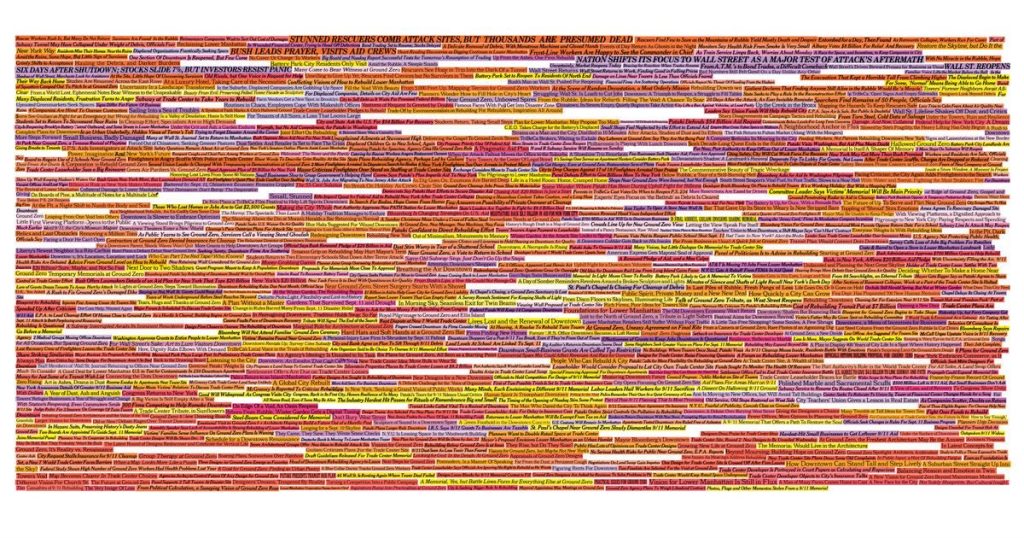A seemingly inescapable fact of my life is that I am a poet, or, at least, that I keep writing poems. Why would I feel the need to do this? I am fascinated by language. But language is fascinating to everyone. It is through language that we describe and therefore create the world we live in, and it is through language that we describe and therefore create ourselves. If the world is difficult and life is difficult, it may not be that there is something wrong with life or the world—it may be that there is something wrong with our descriptions.
We usually think that there is something and then there is talking about something, and that the something is substantial and real and the talking about it is secondary. But for the human mind there is no way to separate something from talking about something. Even perception is, to some extent, a process of talking about something.
I suppose you could say that language is humanity, because human consciousness is language-making consciousness. Language is so close to us we cannot understand what it is. We are “in” language the way a fish is in water: for the fish, water is just the way things are.
I have been wondering about language almost all my life, and after all these years of exploration, I am no closer to understanding it than I have ever been. Still, in my poetry I am always writing about this effort to understand language. It seems to be my chief topic: Can we know what language is? Can we know what we are? The poet Paul Celan writes, “Whenever we speak with things in this way (in poetry) we dwell on the question of their where-from and where-to, an open question without resolution.”
So language is, on the one hand, a prison: we are literally locked inside language, created by, defined by language, and can only see as far as we can say. On the other hand, language can also free us: it can open our imagination and allow us to reach out to the world—and fly beyond it. This is what poets try to do.
They always fail, but the point is not to succeed but to make the attempt.
In Zen practice we are always trying to stand within language in a fresh way, to open up the hand of thought, and play with language and let language play with us. This means we come to understand and dwell within language in many ways. Each word means something and not something else. But also each word is gone even as we speak it, and so it isn’t anything. When we speak about something we might think we are understanding it or controlling it, but that is not so. When we are speaking about something we are also—and mainly—speaking about nothing. Speaking is just being ourselves, expressing ourselves. When we get tangled up in the something we think we are speaking about, we suffer.
All language is singing. Music doesn’t have any describable meaning, yet it is vital to our lives. But we don’t know this. We hold onto objects we have created with our language, objects that don’t exist as we imagine that they do, and we suffer. If we could experience language as it really is for us, we could be free from the suffering language creates. This doesn’t mean that we would be free from pain or sorrow. Only that we would be free from the special sort of anguish that human beings feel when they are lonely and estranged from themselves, others, and the world.

This thought lies at the heart of Buddhism. The first three practices of the eightfold path are right view, right intention, and right speech. These make right conduct possible, and when there is right conduct, there can be meditation practice and mindfulness, which lead to wisdom, thereby reinforcing right view. So from the first, the Buddha saw that our language conditions our spirituality through our views, intentions, and uttered words, and that training in an increased awareness of this process has to be the starting point for spiritual practice. In later Buddhist thought this insight was strengthened and made more explicit with the teachings on emptiness, which understand the nature of human reality to be “mere designation.”
As a spiritual teacher operating in the real world with real students, the Buddha was sophisticated yet quite practical in these matters. Like Socrates, he was a master of dialogue. He knew that getting caught up in language was a trap. He saw that nothing was more fundamental than right view—out of right view everything good unfolds—but he also saw that right view isn’t some doctrine or propositional truth. People sometimes ask me, what is the Buddhist view of this or that? But there is no Buddhist view of this or that. The Buddhist view is a non-view, but not a non-view that is the opposite of a view, a wishy-washy noncommittalism. Non-view includes various views that arise in response to conditions. Non-view is an attitude, a spirit of openness, kindness, and flexibility with regard to language. Non-view is a way to stand within language, to make use of language, to connect without being caught by—and separated from the world by—language.
Buddha spent his life talking to people. In fact, he was one of the greatest masters of talking to people in recorded history. One gets the sense in the suttas that the Buddha talked not because he was particularly loquacious, or because he was given to elaborate explanations, but in order to help people see through the smoke screen of their own language and views. Once someone asked him for his secret in answering questions as effectively as he did. He said that he had four ways of answering questions. One way was categorically—just to say yes or no without ambiguity. The second way was to examine the question analytically, clarifying definitions and trying to determine what was actually being said, usually by deconstructing it. Most of the time when the Buddha employed this method there was no need to answer the question: under analysis the question proved meaningless. The third way was by posing a counterquestion, the purpose of which was to bring the questioner back to his or her own mind, redirecting attention away from the entanglement of the language of the question to something real that stood behind it. The fourth way was simply to put the question aside, knowing that some questions are so hopelessly entangled that to take them up at all means beating your head against a wall—there is no end to it and you end up with a bloody head. To put the question aside is simply to walk around the wall. This way you can get to the other side without beating your head bloody. So sometimes the Buddha’s response to a question was silence.

In his discussion of right speech the Buddha also demonstrated the subtle and nuanced understanding that words do not have fixed meanings and ought never to be taken at face value. The meaning of a word depends on the context: who is speaking and listening, the tone of voice employed, the underlying attitude, and the situation in which the words are spoken. The very fact that the Buddha did not recommend that his words be written down and that he allowed others to explain the teachings in their own words, insisting that ordinary language, not special holy language, be used, shows that he understood language to be a process—essentially a dialogue, a dynamic experience—rather than a tool of exact description or explanation. The Buddha saw that far from being a neutral conduit for the conveying of preexisting meanings, language is an ever-shifting vehicle for the self, and that the way to clarify the self and the world is to hold language in an accurate and sensitive way.
Of all the Buddhist teachings the Zen masters of ancient China inherited from India, what they emphasized most was this point about language:
A monk asked Zhaozhou, “What is the Great Perfection of Wisdom?”
Zhaozhou replied, “The Great Perfection of Wisdom.”
Another monk asked him, “What is meditation?”
Zhaozhou replied, “Non-meditation.”
“How can meditation be non-meditation?”
“It’s alive.”
Another monk: “What is one word?”
Zhaozhou: “Two words.”
A monk asked Fengxue, “How can I go beyond speech and silence?”
In response, Fengxue quoted lines from a famous poem.
What makes us miserable, what causes us to be in conflict with one another, is our insistence on our particular view of things: our view of what we deserve or want, our view of right and wrong, our view of self, our view of other, our view of life, our view of death. But views are just views. They are not ultimate truth. There is no way to eliminate views, nor would we want to. As long as we are alive and aware there will be views. Views are colorful and interesting and life-enhancing—as long as we know they are views. The Chinese Zen masters are asking us to know a view as a view, and not to mistake it for something else. If you know a view as a view, you can be free of that view. If you know a thought as a thought, you can be free of that thought.
Going beyond language through language is something we can practice and develop through meditation, study, and awareness in daily life. In meditation we can learn to pay attention not only to sensation but also to emotion and thinking. Learning to let thinking come and go, we can eventually understand a thought as a thought and a word as a word, and with this understanding we can find a measure of freedom from thoughts and words. We can begin to appreciate Buddhist thought not as a new set of concepts that we are to adhere to, but as a kind of mental yoga, a counterweight to the concepts we already unconsciously hold and that hold us, locking us into a small, temporary, atomized self. When in daily living we learn to return again and again to where we are in body, emotion, and mind, we are learning to hold our language and views lightly, to see that they are ever-evolving currents of being, that they are not only ours but belong to everyone else as well. When we cultivate the practice of paying close attention to the way we talk to ourselves, we won’t fool ourselves too much. Another old Zen master used to call out to himself, “Don’t be fooled by anything.” And he would answer, “I won’t be!”
Thank you for subscribing to Tricycle! As a nonprofit, we depend on readers like you to keep Buddhist teachings and practices widely available.
